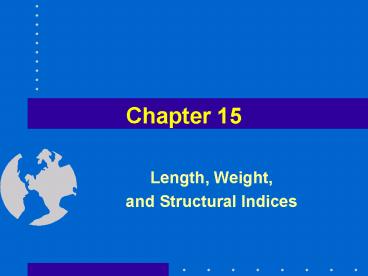Length, Weight, - PowerPoint PPT Presentation
1 / 33
Title:
Length, Weight,
Description:
Account for wind & fish, boat motion. Preservation. Weight goes up about 8 ... For fish with b 3, the values of K & C change with length (poor choice) ... – PowerPoint PPT presentation
Number of Views:84
Avg rating:3.0/5.0
Title: Length, Weight,
1
Chapter 15
- Length, Weight,
- and Structural Indices
2
15.1 Introduction
- Methods of measurement of fish structure
- Calculations of indices
- Interpretation of Structural Indices
3
Length frequency data
- Estimate benefit to commercial and recreational
fisheries - Basis for estimating growth, standing crop, and
production - Production (kg/ha/year)
4
Fish Length Weight
- Length defines legal size for harvest
- Relative number of fish in certain size
categories...measure of management objectives - Harvest (metric tons) and Standing Stock (kg/ha)
X
5
Fish Length Weight (cont.)
- Growth described by weight at age or weight
gain/year - Weight Length...condition
Good Condition
Weight 1 year fish
Poor Condition
Length 1 year fish
6
15.2 Considerations
- Does gear bias influence length and weight
measures?
Vs.
- How many fish measured or subsampled for
measurement?
Vs.
7
Considerations (cont.)
- Does gender influence length weight measures?
- Weight more error-prone than length.
Vs.
8
Length groups and bin sizes
- Convention use 10.0 - 10.99 instead of 9.5 -
10.5
- Whole body measurements
- Maximum standard length - least
convenient (1) - Fork length (2)
- Natural total length (3)
- Maximum total length (4)
9
Measuring devices
- Measuring boards - 1 to measure, 1 to
record - Calipers - small fish
- Measuring tape - large marine species
- Electronic measuring boards - records
automatically
10
Measuring conventions
- Fish mouth closed
- Head left, tail right
Should be Closed
Wrong Direction
- Measure fresh to avoid shrinkage and rigor mortis
11
Weighing devices
- Spring loaded scales
- Electronic scales (battery-powered) with digital
readout - Hanging scales measure fish in bulk or large fish
12
Weighing conventions
- Remove excess moisture on fish
- Periodic calibration of scales
- Remove excess moisture on scale
- Tare often
- Account for wind fish, boat motion
13
Preservation
- Weight goes up about 8
- Length goes down about 2
- Use fresh specimens if possible
14
15.3 Weight-Length Relationships
- So length can be converted to weight or vice
versa - Condition - variation from expected weight at a
given length
15
Power function
- W a Lb
- B gt 3...fish get rounder as they grow
- B lt 3...fish get less rotund as they grow
- B 3...fish stay same shape as they grow
16
Transformation
- Estimate a and b using linear regression
- Log10(W) Log10(a) b Log10(L)
- Y intercept slope X
17
15.4 Indices of Condition
- Fulton condition factor
- Relative condition factor
- Relative weight
18
Fulton Condition Factor
- K (W/L3) 100,000 (millimeters, grams)
- C (W/L3) 10,000
- (inches, pounds)
- For fish with b gt 3, the values of K C change
with length (poor choice)
19
Relative Condition Factor
- Kn (W/W')
- W' a Lb (for study population, use L,W data
and linear regression)
L
W
Lake Owen
20
Relative Weight
- Wr (W/Ws) 100
- Log10(Ws) a' b Log10(L) (where a'
Log10(a) ) - Note a' and b come from literature
- If Wr ltlt 100 then fish in poor
condition
21
Relative weight (cont.)
- Varies with length (possible) and time of year
- Related to fat content
- Related to fecundity egg quality
- Related to growth
22
15.5 Weight Models
- Swingle's F/C ratio
- F weight of forage species
- C weight of carnivores
- Desirable range 3-6
23
Problem...some F are too large to be eaten by C
- Swingle's Y/C ratio
- Y wt of fish in F group available to average
adult in C group - C weight of carnivores
- desirable range 1-3
24
Other Swingle Metrics
- Swingle's A_t - percentage of total weight of
fish population that is harvestable - Examples 60-85 for LMB and BG
- Swingle's E - percentage of weight of fish
community composed of one species or group - Example LMB in small impound...14-25
25
Jenkins and Morais metric
- AP/P ratio
- AP biomass of prey small enough to be eaten by
a particular size predator - P cumulative biomass of predators of different
sizes - Plotted on a log10 vs log10 scale
- Curve should be above the 11 line to have
sufficient prey for predators
26
15.6 Length-Frequency Histograms reflect
- Reproduction
- Recruitment
- Growth
- Mortality
27
Guidelines
- Sample 100 fish of at least stock size
- Bin sizes
- 30-cm fish 1-cm interval
- 60-cm fish 2-cm interval
- 150-cm fish 5-cm interval
28
Guidelines
- Y-axis
- Absolute number of fish per length group
- Percentage in each length group
- Standardized - ex. number per hour electrofishing
29
15.7 Length-Frequency Indices
- PSD RSD
- YAR
- Population and Community Models
30
Stock-Density Indices PSD
- PSD of fish gt quality size / of fish gt
stock size 100 - Note for stock quality size see Table 15.2, pg
464 - Round to the nearest whole number
31
Stock-Density Indices RSD
- RSD of fish gt specified size / of fish gt
stock size 100 - Round to the nearest whole number
- Stock size (S) Memorable (M)
- Quality size (Q) Trophy (T)
- Preferred (P)
- Traditional RSD vs Incremental RSD
32
Stock-Density Indices Young-Adult Ratio
- YAR fish lt 15 cm / fish gt 30 cm
- Expected range at moderate LMB density 1-10
33
Stock Density Indices Community Models
- Balanced Populations have predictable PSD
- Examples
- Bluegill 20-60
- Crappie 30-60
- Largemouth bass 40-70

